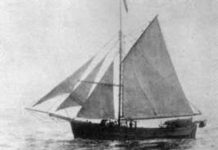On the night of 4 August 1689, an army of fifteen hundred Iroquois warriors crouched on the south shore of the St. Lawrence River. They had arrived undetected from their homelands south of Lake Ontario, and were poised to inflict a fearful vengeance upon New France: directly across the river from the Iroquois camp was Montreal’s largest and most prosperous outpost – the village of Lachine.
Situated six miles west of Montreal, Lachine boasted a population of three hundred and fifty. Three garrisoned stockades were located nearby, attesting to the village’s strategic importance.
Background: Denonville and the Iroquois – 1687-88
In July 1687, New France’s governor – Jacques Rene de Brisay, Marquis de Denonville – had led an invasion of the Seneca nation’s homeland, seeking to crush the belligerent tribe. Denonville’s troops burned villages and destroyed fields of crops, but inflicted relatively few casualties. During the winter of 1687-88, the Senecas and the other nations of the Iroquois Confederacy (Cayuga, Mohawk, Oneida and Onondaga) struck back.
War parties attacked outlying homesteads, killing or making prisoners of the settlers, burning the buildings and destroying crops and livestock. They also beseiged the French garrisons at Fort Frontenac and Fort Niagara: effectively imprisoned within their own strongholds, unable to leave even to obtain fresh meat, hundreds of the soldiers died of scurvy. The arrival of smallpox in the colony via ships from France further depleted its troops and militia. France was at war with a coalition of continental powers led by the Netherlands’ Chief Magistrate, William of Orange, and could spare no troops for her American colony.
The escalating attacks by the Iroquois, combined with New France’s diminished fighting strength, forced Denonville to contemplate a change in settlement policy: concentrating the colonists in fortified villages rather than having them scattered in isolated homesteads along the St. Lawrence River. However, Denonville realized that affecting this change would require both time and a respite from the Iroquois’ attacks.
To obtain the latter, he undertook to negotiate a settlement with Five Nations. Emissaries were dispatched to their villages, inviting their chiefs to confer with the governor in Montreal. There, Denonville successfully negotiated a truce that was to be ratified the following year via a formal treaty. His peacemaking efforts received aid from an unexpected source. England’s Catholic King James II, who owed his thone to financial support provided by Louis XIV of France, ordered the English authorities at Albany to ensure their Iroquois allies ceased hostilities against New France. Denonville now had his peace, and looked forward to formalizing it in 1689.
Developments in Europe 1688-89
Shortly thereafter, Europe’s political landscape shifted – to France’s detriment. Two days prior to Christmas 1688, following an invasion of England by forces loyal to William of Orange, James II fled his kingdom. William and his consort Mary (daughter of James II) became joint rulers and, inevitably, engaged England and her colonies in the coalition against France: war was declared on 17 May 1689.
Denonville was oblivious to these developments for several critical months. Ships from France, bearing dispatches dated 20 March and 1 May that would have informed him of the increasing risk of war with England and the likelihood of an attack on New France from the English colonies, did not sail until 23 July.
The governor also had other concerns: the fur flotillas from the west – the economic lifeblood of the colony – were overdue, and the Iroquois had not yet indicated when they would formally sign the peace treaty. Meanwhile, the Montreal area’s military commander, the Chevalier de Vaudreuil, took advantage of the truce with the Iroquois to allow settlers to quit the crowded discomfort of the fortified stockades and return to their homesteads.
However, the English authorities at Boston and Albany were aware of developments in Europe as early as 1 March. By April, rumours of war were circulating: several weeks later, the formal declaration was received. The Iroquois were immediately informed. Their plans for ratifying the peace treaty with Denonville were quickly forgotten, replaced by plans for vengeance.
Sources:
- Costain, Thomas B. The White and the Gold: The French Regime in Canada. Doubleday & Company, Inc., Garden City, New York, 1954.
- Eccles, William J. Canada under Louis XIV. McClelland and Stewart Limited, Toronto, 1964.






